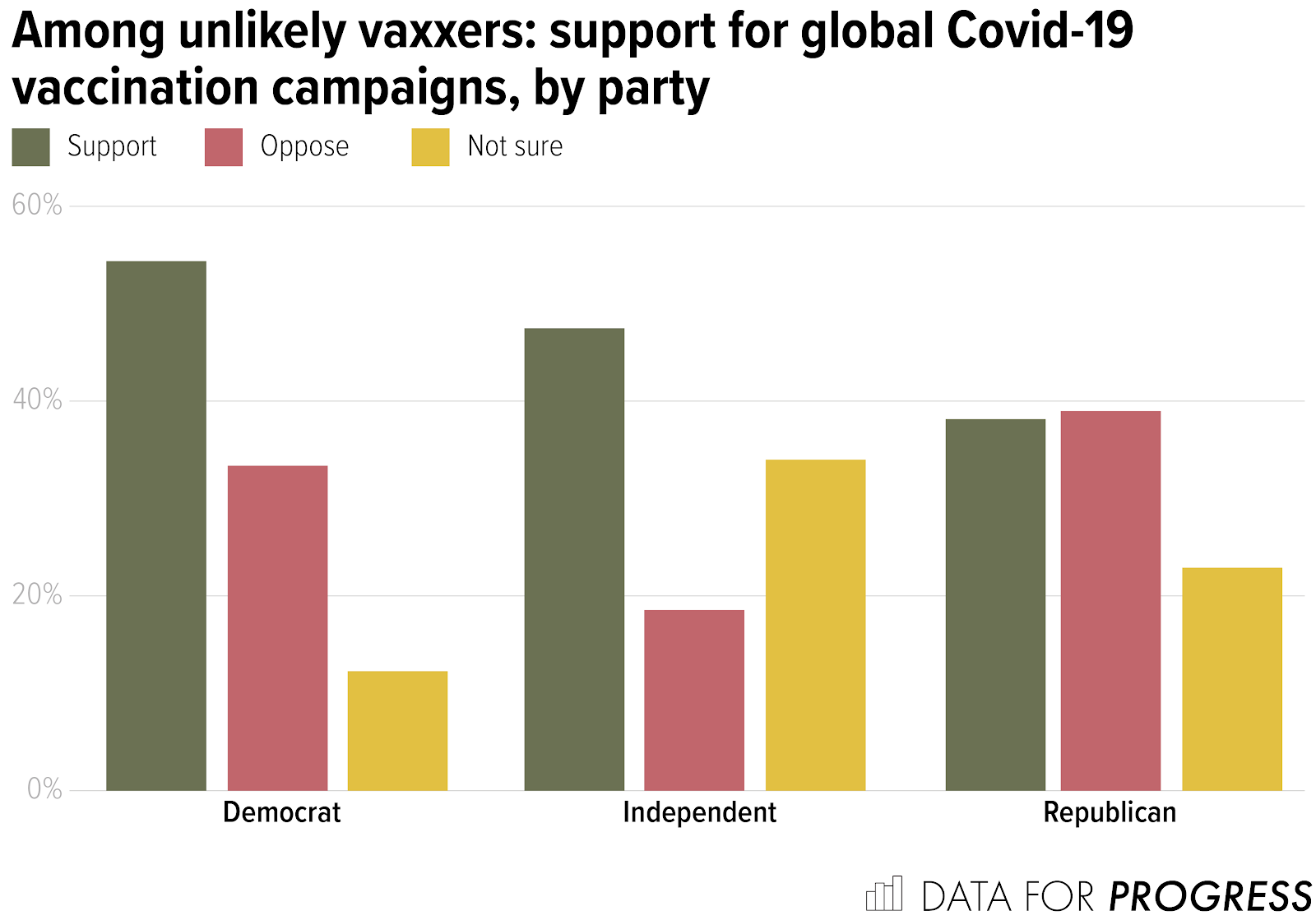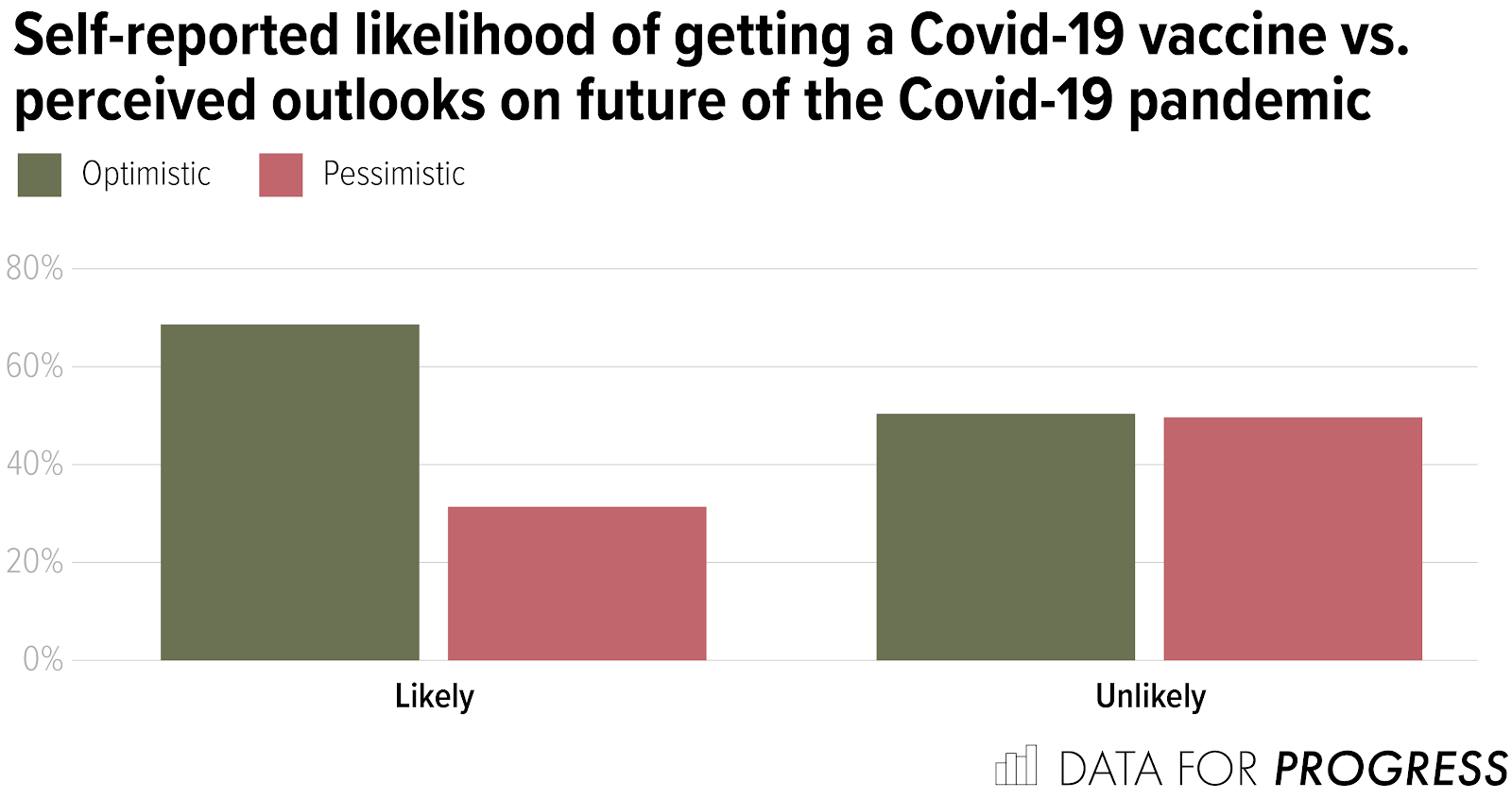A Significant Number of Vaccine Skeptics Could Be Swayed to Take the Shot
By Zachary L. Hertz, Yonatan Margalit, and Emma Winey
Over a year into the coronavirus pandemic, Americans have become increasingly optimistic that a return to normalcy may be in sight. A March 14 CBS News/YouGov poll found that 64% of Americans think that efforts to contain the virus are going well. Additionally, a March 15 Rasmussen poll found that 42% of Americans think the worst of the pandemic is now behind us.
But as cases plateaued in early March, Dr. Anthony Fauci cautioned against complacency and warned that timelines to return to normalcy by the end of 2021 were dependent on high levels of vaccination. The United States has made aggressive leaps in its vaccination timeline; by March 15, over 2 million vaccinations on average were being administered every day, and President Joe Biden has announced that all American adults will be eligible to receive a vaccination by May 1.
Still, significant roadblocks to widespread vaccination remain. A March 8 poll by Monmouth University found that nearly one in four Americans would likely never get the vaccine if they could avoid it. But what drives resistance to vaccinations? There is more reason for concern if a significant portion of the population believes the vaccines are harmful than if, perhaps, people are just being cautious. Are those who refuse to get vaccinated still supportive of the vaccination campaign overall?
To answer this, we included a battery of questions on the Data For Progress Coronavirus Tracking Poll and analyzed the results. Americans seem to be increasingly likely to get vaccinated and broadly support global vaccination efforts. We find evidence to support a cautiously optimistic outlook on the future of the pandemic, even in the face of significant resistance to vaccination.
Americans’ Likelihood of Getting a Coronavirus Vaccine Is Rising
Before delving into the group of respondents who are unlikely to get vaccinated, two important points should be made about the trends in likelihood to get the vaccine.
The first point is quite apparent—vaccinations are going up. In a roughly three week span, from February 9th to March 2nd, the number of vaccinated respondents went up by about 9 percentage points. In the future, we would expect to see even greater increases in the vaccination rate now that another vaccine has been approved by the FDA, more people are becoming eligible to receive the vaccine, and kinks in the vaccination process continue smoothing out.
The second point is less apparent: Americans’ likelihood of getting the vaccine is trending in the more likely direction.
As mentioned before, 9% of respondents got vaccinated in a three week span. In that same time period, the percentage of those reporting that they are “very likely” and “somewhat likely” to get a coronavirus vaccine dropped about 3 and 4 percentage points, respectively, for a total of 7 percentage points. Consequently, at least some of those people who indicate that they are either “somewhat unlikely” or “very unlikely” to get a coronavirus vaccine are ending up getting vaccinated.
The remaining 2 percentage points of newly-vaccinated respondents is nearly all accounted for in the drop of “very unlikely” vaxxers, not at all by “somewhat unlikely” vaxxers. Hypothetically, this breakdown could mean two things. One — less likely but still plausible — is that “very unlikely” vaxxers are leaping past the “somewhat unlikely” stage and settling into one of the “likely” ones. This could explain the discrepancy in the percentage of those vaccinated increasing more than the cumulative “likely” groups are decreasing.
More likely, however, is that the “somewhat unlikely” vaxxers are shifting into the more likely groups or even getting vaccinated, while the “very unlikely” vaxxers are replenishing that lost group of “somewhat unlikely” vaxxers. Both possibilities could simultaneously be at play, of course, but the latter is probably playing the larger role.
Even Americans Who Are Unlikely to Take the Vaccine Support Global Vaccination Campaigns
Digging more into this idea, we compared Americans’ likelihood of getting a vaccine to a question added to the most recent wave of the DFP tracking poll:
“Regardless of how you feel about personally getting a Covid-19 vaccination, do you support or oppose global vaccination efforts to eradicate Covid-19?”
An overwhelming majority — nearly 70% — of Americans support the global mission to end the pandemic through vaccination. The other 30% are split fairly evenly between opposing vaccinations and being unsure where they stand.
It is important to distinguish between one’s likelihood to get a coronavirus vaccine and one’s support of global vaccination efforts to end the pandemic. When we break down the respondents to the previous question by self-reported likelihood of getting a coronavirus vaccine, an interesting point emerges. First, even among those who report being unlikely to get the vaccine themselves, there is plurality support for vaccination campaigns. 45% of those unlikely to get vaccinated support the efforts, 34% oppose, and 21% are unsure.
These numbers show that there is a rather significant group of Americans who don’t think they’ll take the vaccine but still want the pandemic to end through mass inoculation. Perhaps unsurprisingly, those who report being “somewhat unlikely” to get the vaccine are more supportive of these campaigns than those who are “very unlikely.” There is a 41-percentage-point margin between their levels of support — 71% to 30%, respectively.
The data suggest that there is potential to persuade a significant group of Americans who currently report being unlikely to get the vaccine to change their mind and get one. The receptiveness to global vaccination campaigns of “somewhat unlikely” vaxxers is much more similar to that of the “very likely” and “somewhat likely” vaxxers.
In an open-ended survey question, we asked respondents unlikely to get a coronavirus vaccine why they were unlikely. Many respondents reported that they wanted to wait and see or they were worried about side effects. These were more common among “somewhat unlikely” vaxxers than “very unlikely” ones. Responses that centered on not trusting the vaccine, not needing it, or ones that were simply vaccine-related conspiracies comprised a higher proportion of “very unlikely” vaxxers.
The Politics of Vaccination Resistance
To further understand what drives opposition to the coronavirus vaccine, we first analyze the demographics of the unlikely vaxxers (including both the “somewhat unlikely” and “very unlikely” subgroups). When analyzed by political parties, we find that unlikely vaxxers skew toward the GOP, with 29% identifying as Democrats and 55% identifying as Republicans. This is noticeably higher than the 39% of the general population that identifies as Republican.
While there were significant partisan differences between unlikely vaxxers and the general population, we did not observe any notable differences in the racial composition. 62% of unlikely vaxxers identify as white, 11% as African-American, 19% as Hispanic/Latino, and 8% as other, nearly matching the weighted racial breakdown of the overall population.
For further analysis, we broke down these partisan groups of unlikely vaxxers by their support for global vaccination campaigns. In keeping with our earlier findings on unlikely vaxxers, partisanship proves a powerful force shaping support of global vaccination campaigns. 54% of Democrats that stated they are unlikely to receive a coronavirus vaccine still voiced support for mass inoculation, while 33% stood in opposition. Only 38% of unlikely-vaxxer Republicans support global vaccination campaigns. Notably, Republicans are split on the issue; less than 1-percentage-point separates GOP unlikely vaxxers in their support (38%) and opposition (39%) to global vaccination efforts.
Those Unlikely to Get the Vaccine Are Less Optimistic About the Pandemic’s Future
Finally, we compared one’s likelihood of getting a coronavirus vaccine to their feelings on whether or not other people are optimistic or pessimistic about the future of the pandemic. Those indicating they were likely to get vaccinated were much more likely to say people were optimistic about the future of the pandemic than those who were unlikely to get vaccinated.
The lower perceived optimism among unlikely vaxxers makes sense. Those unlikely to get the vaccine, for reasons other than fear of side effects, probably do not think the pandemic was ever that big of an issue. As has been shown throughout the entirety of the pandemic, Republicans — who are disproportionately likely to fall into the unlikely vaxxer group — take the coronavirus less seriously. So it would stand to reason that unlikely vaxxers think people are generally pessimistic if they themselves do not see the coronavirus as a legitimate concern.
Broken down by the more specific likelihood groups, we see a decrease among those who think people are optimistic, as we go from “very likely” to “very unlikely” vaxxers. Naturally, there is an increase among those who think people are pessimistic as we go in the same direction. However, the difference between “somewhat unlikely” vaxxers and “very unlikely” vaxxers is not significant.
This is interesting considering there was a massive difference between the responses of these two sub-groups for the global vaccination efforts. Analyzing the two graphs together re-emphasizes what we’ve seen throughout the data: there are definite similarities between the “somewhat unlikely” and “very unlikely” vaxxers, but the former holds a more malleable stance toward getting a coronavirus vaccine.
Conclusion
While about one-third of Americans still feel that they are somewhat or very unlikely to get the coronavirus vaccine, we find evidence to suggest that even those hesitant about the vaccine are increasingly likely to get vaccinated. While a majority of those who were unlikely to get the vaccine identified as Republican, there were no significant differences in racial composition between those who were unlikely to get the vaccine and respondents as a whole. There is a broad level of support for the global vaccination campaign, and crucially, this support persists at high levels even among those who are somewhat unlikely to get the coronavirus vaccine. While a significant proportion of Americans remain reluctant, we conclude that opinion on the vaccine is shifting and may continue to do so as vaccinations continue.
Zachary L. Hertz (@ZacharyLHertz) is a Research Associate at the Tufts Public Opinion Lab.
Yonatan Margalit (@tunadahuman) is a junior majoring in political science at Tufts University.
Emma Winey (@EWiney8) is a junior majoring in political science at Tufts University.
Methodology
These questions were included as part of the Data for Progress Coronavirus Tracking Poll, fielded each week using respondents recruited via Lucid. Post-stratification weights are implemented to make the sample nationally representative of American adults by gender, age, region, education, race, and the interaction of education and race. The data are also weighted to match vote shares from the 2020 Presidential election. The margin of error is ± 3.2 percentage points.








